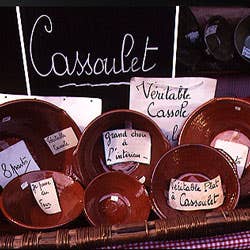
The Cassole
Among the many mysteries surrounding cassoulet is the question of its exact origins. It is believed to have been born in Castelnaudary, but this has been disputed. More certain is the provenance of the dish's name, which derives from cassole—originally cassolo in the Occitan language—meaning the dish in which a cassoulet is customarily prepared. This brick-colored earthenware bowl was, it seems, first fabricated in Issel, a village north of Castelnaudary once famous for its pottery. Today, a single enterprise continues to craft cassoles by hand: Poterie Not Freres, near the village of Mas-Saintes-Puelles.
The Not family has been manufacturing cassoles in this spot for 35 years. "We still use clay from around Issel," says Aime Not. The brothers make the cassole in the traditional way, glazed in the interior and along the rim but unglazed on the outside. Aime's brother Robert adds that in the old days this was done in order to save money—but it has the additional convenience of making the cassole much easier to hold when taken out of the oven.
Robert says that the cassole predates the invention of cassoulet and was used for cooking meat in salted water. But when used to make cassoulet, the cassole allowed more beans to be exposed to the oven's heat, thus forming the brown crust.
EDITOR'S NOTE: We were unable to find a real French cassole in the U.S. But in the use-what's-at-hand spirit that gave birth to cassoulet, we found that any vessel appropriate for slow cooking, like a cast-iron pot (enameled or not) or a big earthenware pot, preferably glazed on the inside (we used the bottom of a clay cooker), works well. The pot should be wide enough to allow a good crust to form.
Keep Reading
Continue to Next Story










